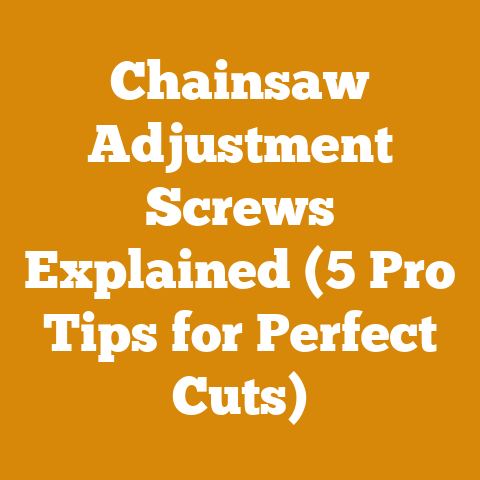Bumper Spikes Installation Tips (5 Must-Know Arborist Hacks)
Ever struggled with your chainsaw sinking too deep into the wood, or fighting to maintain control during a cut? I certainly have. That’s where bumper spikes, also known as felling dogs or bucking spikes, come into play. They’re not just decorative; they’re essential for leverage, control, and safety. In this guide, I’m going to share five arborist hacks for bumper spike installation that I’ve learned over years of felling and processing timber. These aren’t just tips; they’re techniques that can transform your chainsaw operation, whether you’re a seasoned pro or just starting out.
Understanding Bumper Spikes: More Than Just Metal
Before diving into the installation hacks, let’s clarify what bumper spikes are and why they matter. These metal protrusions, typically mounted near the base of the chainsaw bar, provide a fixed point of contact against the wood. This allows you to pivot the saw, control the depth of cut, and reduce the physical strain of holding the saw steady.
The Evolution of Bumper Spikes
I remember when bumper spikes were a rarity on smaller chainsaws. They were primarily found on professional-grade saws used for felling large trees. Now, they’re becoming increasingly common on a wider range of models, which is a testament to their value. Their design has also evolved, from simple single spikes to more aggressive double-spike configurations.
Why Bumper Spikes Are Essential
- Leverage: They provide a stable pivot point, allowing you to use the saw’s weight to your advantage.
- Control: They help maintain a consistent cutting depth and prevent the saw from kicking back unexpectedly.
- Safety: By reducing strain and improving control, they minimize the risk of accidents.
- Efficiency: They make cutting faster and easier, especially when bucking logs on the ground.
Hack #1: Choosing the Right Bumper Spikes for Your Saw
Not all bumper spikes are created equal. Selecting the right size, shape, and material is crucial for optimal performance.
Sizing Matters
The size of the bumper spikes should be proportional to the size of your chainsaw and the type of wood you typically cut. Smaller saws benefit from smaller, less aggressive spikes, while larger saws can handle larger, more aggressive ones.
- Small Saws (under 50cc): Opt for single-spike configurations with a length of 1-2 inches.
- Medium Saws (50-70cc): Consider double-spike configurations with a length of 2-3 inches.
- Large Saws (over 70cc): Use heavy-duty double-spike configurations with a length of 3-4 inches.
Material Selection
Bumper spikes are typically made from steel or aluminum. Steel is more durable and provides better grip, but aluminum is lighter and can reduce fatigue.
- Steel: Ideal for heavy-duty use and abrasive wood types.
- Aluminum: Suitable for lighter tasks and softer wood types.
Matching Spikes to Wood Type
The type of wood you cut also influences your choice. Hardwoods like oak and maple require more aggressive spikes than softwoods like pine and fir.
- Hardwoods: Choose spikes with sharp, aggressive teeth for maximum grip.
- Softwoods: Opt for spikes with smoother, less aggressive teeth to prevent the saw from bogging down.
My Experience: I once tried using small, aluminum spikes on a large oak log. The spikes quickly wore down, and I struggled to maintain control of the saw. Switching to larger, steel spikes made a world of difference.
Takeaway: Choose bumper spikes that are appropriately sized, made from the right material, and suited to the type of wood you typically cut.
Hack #2: Precision Installation: Ensuring a Secure Fit
Proper installation is critical for the safety and effectiveness of your bumper spikes. A loose or improperly installed spike can be dangerous and compromise your control of the saw.
Gathering Your Tools
Before you begin, gather the necessary tools:
- Wrench or Socket Set: To tighten the mounting bolts.
- Screwdriver: To remove the existing hardware.
- Torque Wrench: To ensure proper tightening of the bolts (recommended).
- Threadlocker: To prevent the bolts from loosening over time (e.g., Loctite).
- Cleaning Supplies: To clean the mounting surface.
Step-by-Step Installation
- Remove the Existing Hardware: Carefully remove the bolts or screws that hold the existing bumper spikes (if any) or the cover plate in place.
- Clean the Mounting Surface: Thoroughly clean the mounting surface with a wire brush or solvent to remove any dirt, debris, or old threadlocker.
- Position the New Bumper Spikes: Align the new bumper spikes with the mounting holes.
- Apply Threadlocker: Apply a small amount of threadlocker to the threads of the mounting bolts.
- Tighten the Bolts: Tighten the bolts to the manufacturer’s specified torque using a torque wrench. If you don’t have a torque wrench, tighten the bolts snugly but avoid over-tightening, which can strip the threads.
- Test the Installation: Check the stability of the bumper spikes by applying pressure to them. They should be firmly attached and not wobble or move.
Common Mistakes to Avoid
- Over-tightening: This can strip the threads and damage the mounting surface.
- Under-tightening: This can cause the bolts to loosen over time, compromising the stability of the spikes.
- Skipping Threadlocker: This can lead to the bolts loosening due to vibration.
- Ignoring the Manufacturer’s Instructions: Always refer to the manufacturer’s instructions for specific torque recommendations and installation procedures.
My Experience: I once rushed the installation process and didn’t use threadlocker. After a few hours of cutting, the bolts had loosened, and the bumper spikes were wobbling. I had to stop and re-tighten them, which wasted valuable time.
Takeaway: Take your time, use the right tools, follow the manufacturer’s instructions, and don’t skip the threadlocker. A secure installation is crucial for safety and performance.
Hack #3: Customizing Bumper Spikes for Specific Tasks
Sometimes, the stock bumper spikes that come with your chainsaw aren’t ideal for the specific tasks you’re performing. Customizing them can significantly improve your efficiency and control.
Modifying Existing Spikes
- Sharpening: Sharpening the teeth of your bumper spikes can improve their grip, especially when cutting hardwoods. Use a file or grinder to carefully sharpen the tips of the teeth, being careful not to remove too much material.
- Bending: Bending the spikes slightly can change their angle of attack and improve their effectiveness. Use a vise and a hammer to carefully bend the spikes to the desired angle.
- Adding Extensions: Adding extensions to your bumper spikes can provide more leverage and control when felling large trees. You can fabricate extensions from steel or aluminum and attach them to the existing spikes using bolts or welding.
Creating Custom Spikes
For more specialized tasks, you can create custom bumper spikes from scratch. This requires more skill and equipment, but it allows you to tailor the spikes to your exact needs.
- Material Selection: Choose a durable material like steel or tool steel.
- Design: Design the spikes to match the specific contours of your chainsaw and the type of wood you’ll be cutting.
- Fabrication: Use a metal lathe, milling machine, or welding equipment to fabricate the spikes to your specifications.
- Installation: Install the custom spikes using bolts or welding.
Case Study: Custom Spikes for Stump Removal
I once had a project that involved removing a large number of tree stumps. The stock bumper spikes on my chainsaw weren’t providing enough leverage to effectively cut through the dense root systems. I fabricated custom spikes with longer, more aggressive teeth that allowed me to pivot the saw more easily and cut through the roots with greater efficiency. This significantly reduced the time and effort required to complete the project.
Takeaway: Don’t be afraid to modify or create custom bumper spikes to suit your specific needs. A little customization can go a long way in improving your efficiency and control.
Hack #4: Mastering the Techniques: Using Bumper Spikes Effectively
Having the right bumper spikes is only half the battle. You also need to master the techniques for using them effectively.
The Pivoting Technique
The primary purpose of bumper spikes is to provide a pivot point for the chainsaw. To use this technique effectively:
- Engage the Spikes: Drive the spikes into the wood.
- Pivot the Saw: Use the spikes as a pivot point to swing the saw through the cut.
- Maintain Control: Keep the spikes engaged in the wood throughout the cut to maintain control and prevent the saw from kicking back.
The Walking Technique
This technique is useful for bucking logs on the ground.
- Engage the Spikes: Drive the spikes into the log.
- Pivot the Saw: Use the spikes as a pivot point to make a partial cut.
- Release and Re-engage: Release the spikes and move the saw forward, re-engaging the spikes in a new position.
- Repeat: Repeat the process until you have cut through the log.
The Felling Technique
When felling trees, bumper spikes are essential for controlling the direction of the fall.
- Make the Face Cut: Use the spikes to control the depth and angle of the face cut.
- Make the Back Cut: Use the spikes to control the depth and angle of the back cut, leaving a hinge of uncut wood.
- Drive Wedges: Drive wedges into the back cut to help direct the fall of the tree.
Practice Makes Perfect
Mastering these techniques requires practice. Start with smaller logs and gradually work your way up to larger ones. Pay attention to how the saw feels and how the spikes are engaging with the wood.
My Experience: I initially struggled with the pivoting technique. I would often lose control of the saw and make uneven cuts. With practice, I learned to feel the balance of the saw and use the spikes to my advantage. Now, I can make precise, controlled cuts with ease.
Takeaway: Practice the pivoting, walking, and felling techniques until they become second nature. The more comfortable you are with these techniques, the more efficient and safe you will be.
Hack #5: Maintenance and Longevity: Keeping Your Bumper Spikes in Top Condition
Proper maintenance is essential for extending the life of your bumper spikes and ensuring their continued effectiveness.
Regular Cleaning
Clean your bumper spikes regularly to remove dirt, debris, and sap. Use a wire brush or solvent to clean the spikes, paying particular attention to the teeth.
Sharpening and Repair
Sharpen the teeth of your bumper spikes as needed to maintain their grip. Repair any damage to the spikes, such as cracks or bends, as soon as possible.
Preventing Rust and Corrosion
Apply a coat of oil or grease to your bumper spikes to prevent rust and corrosion. This is especially important if you live in a humid climate or work in wet conditions.
Storage
Store your chainsaw in a dry place when not in use. This will help prevent rust and corrosion on the bumper spikes and other metal parts.
Inspection
Inspect your bumper spikes regularly for signs of wear and tear. Replace them if they are worn, damaged, or no longer providing adequate grip.
Case Study: The Impact of Regular Maintenance
I once neglected to maintain my bumper spikes. Over time, they became dull, rusty, and covered in sap. They were no longer providing adequate grip, and I was struggling to control the saw. After cleaning, sharpening, and oiling the spikes, they were as good as new. I realized the importance of regular maintenance and have since made it a part of my routine.
Takeaway: Regular cleaning, sharpening, and lubrication will extend the life of your bumper spikes and ensure their continued effectiveness. Don’t neglect this important aspect of chainsaw maintenance.
Bonus Tip: Considering Adjustable Bumper Spikes
While less common, adjustable bumper spikes offer a unique advantage: adaptability. These allow you to change the spike’s projection length, tailoring it to the specific diameter of the log you’re working on. This is particularly useful if you frequently switch between small and large logs. While they might require a bit more initial investment, the added versatility can be worthwhile for some users.
Safety First: Always Prioritize Safe Practices
Before I wrap up, I want to emphasize the importance of safety. Chainsaw operation is inherently dangerous, and bumper spikes are just one tool to help mitigate those risks. Always wear appropriate personal protective equipment (PPE), including a helmet, eye protection, hearing protection, gloves, and chainsaw chaps. Be aware of your surroundings, and never operate a chainsaw when you’re tired or under the influence of drugs or alcohol.
Conclusion: Bumper Spikes – A Small Investment, A Big Difference
Bumper spikes are a seemingly small component of a chainsaw, but their impact on safety, efficiency, and control is significant. By choosing the right spikes, installing them properly, customizing them for specific tasks, mastering the techniques for using them effectively, and maintaining them regularly, you can transform your chainsaw operation and take your wood processing skills to the next level. I hope these five arborist hacks have provided you with valuable insights and practical tips that you can put to use in your own projects. Now, get out there and start cutting with confidence!






